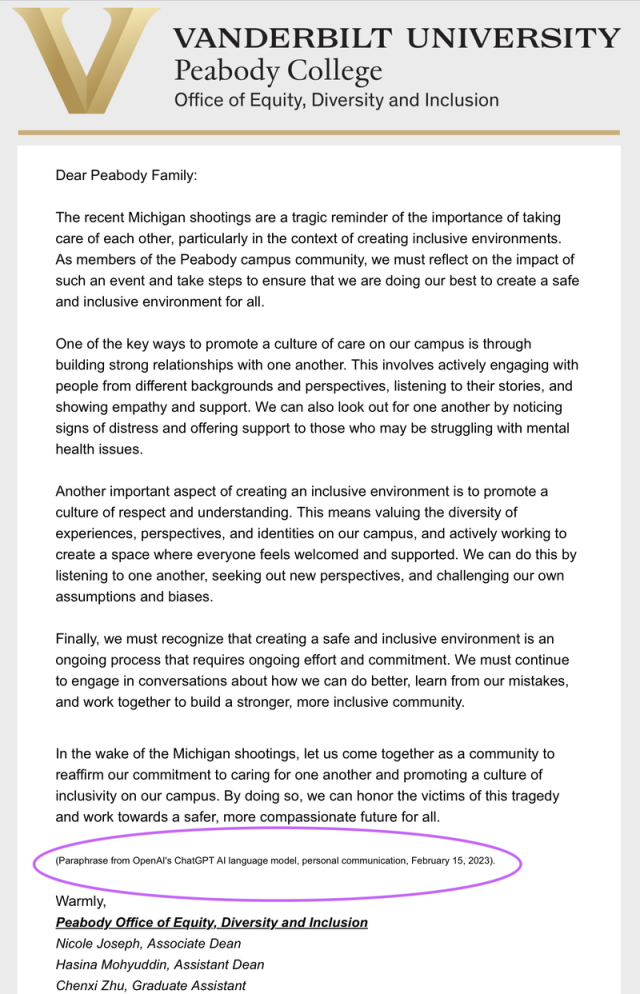
Dear Commons Community,
The United States Department of Education is getting ready to exert greater oversight of online program managers (OPMs) and other education technology companies. In a letter dated February 16th, the USDOE indicated that it is updating its requirements and responsibilities for third-party servicers and institutions. Specifically the letter states that it is updating guidance to institutions that contract with a third-party servicer (TPS) to administer any aspect of the institution’s participation in the student assistance programs authorized under Title IV of the Higher Education Act of 1965, as amended (HEA).
The Chronicle of Higher Education commented on the details of the USDOE statement:
“Third-party servicers” is a label historically reserved for entities that assist institutions in administering federal financial aid to students. But now, sources say, many ed-tech vendors — including those providing online-program management, learning-management systems, and mandatory tutoring — all could fall under that same umbrella. That would make them subject to various requirements: Having to be based in the U.S. Being held responsible with their client institution for any violation of Title IV requirements, and any resulting damages. Submitting an annual, independent compliance audit. Allowing government access to its college contracts
“It’s pretty unprecedented what they’re doing,“ said Katherine Brodie, a lawyer at Duane Morris LLP specializing in education issues. “It’s a sweeping expansion of jurisdiction that we haven’t seen before.”
This appears to be a focused attempt on the part of the USDOE to provide more oversight if not rein in the practices of these vendors.
The Chronicle article with more extensive analysis of the new USDOE requirements is below.
Tony
—————————-
The Chronicle of Higher Education
Education Dept. Shocks Ed-Tech Experts and Colleges With Expansion of Oversight
By Taylor Swaak
February 22, 2023
The U.S. Department of Education has announced a stunning expansion of its interpretation of federal regulations that appears to put a large swath of colleges’ ed-tech vendors on the hook for following more rules, and place the vendors under closer scrutiny.
Updated guidance shared last week stated that, “effective immediately,” the department considers entities that help colleges serve students in their Title IV-eligible programs by providing recruitment and retention services, certain software products, and “any percentage” of educational content and instruction to be “third-party servicers,” with some exceptions. And colleges need to report those arrangements by May 1.
“Third-party servicers” is a label historically reserved for entities that assist institutions in administering federal financial aid to students. But now, sources say, many ed-tech vendors — including those providing online-program management, learning-management systems, and mandatory tutoring — all could fall under that same umbrella. That would make them subject to various requirements: Having to be based in the U.S. Being held responsible with their client institution for any violation of Title IV requirements, and any resulting damages. Submitting an annual, independent compliance audit. Allowing government access to its college contracts
“It’s pretty unprecedented what they’re doing,“ said Katherine Brodie, a lawyer at Duane Morris LLP specializing in education issues. “It’s a sweeping expansion of jurisdiction that we haven’t seen before.”
Higher-ed lawyers and ed-tech experts said they were anticipating that the Education Department would move to expand oversight of online-program managers; there’s been mounting pressure to keep a closer eye on these companies, which often help institutions scale up their online programs for a hefty cut of their tuition revenue. But sources said the release of guidance that reads like a unilateral redefinition of what a third-party servicer is — without first collecting public comments — was shocking, especially given the potential implications for colleges.
It’s not so much about extra paperwork, they said, but about the risk of accidental noncompliance. New legal requirements may also necessitate changes to colleges’ existing contracts with ed-tech companies, and prompt re-evaluations of the services an institution receives.
Some observers seeking greater accountability for institutions and the companies they contract with were pleased by the news. And to be sure, experts who spoke with The Chronicle underscored that they support consumer protection and transparency, along with the department’s having access to more data about colleges’ arrangements with vendors. Sources said the problem is the broadness of the definition, and the confusion it’s already causing across college campuses.
“We know that there are bad actors, and we appreciate the development of regulations to protect students from bad actors,” said Cheryl Dowd, senior director of the State Authorization Network and policy innovations at WCET, an organization that advises colleges on effective technology use. “But we also need to be clear.”
In the hours and days after the letter’s release, sources said they’d received a barrage of messages from college administrators: Is our partner now a third-party servicer? Should we move forward with pending contracts? Revisit or cancel existing contracts? What now? Phil Hill, a partner at the ed-tech consultancy MindWires, said that at least one institution he’d spoken with had, within 48 hours of reading the news, paused operations with a vendor that assists with recruitment.
“People are freaked out right now,” Hill said.
A Department of Education spokesperson wrote in an email that the department’s “greatest concern” in issuing this guidance is “the area of recruitment and activities tied to the administration of federal student-aid funds.” The department will “work with colleges to ensure the requirements are clear and that they have ample time to meet reporting deadlines,” the spokesperson added.
A crackdown of sorts on online-program managers, at least, had been imminent.
A U.S. Government Accountability Office report last year called out the Department of Education for its deficient oversight of online-program managers; it noted, for example, that the department doesn’t know the number of colleges contracting with OPMs (the report estimated at least 550 colleges). The industry’s dominant payment model, revenue-share agreements, has also evoked concerns of predatory and deceptive recruiting practices. An oft-cited case is that of the University of Southern California, where The Wall Street Journal reported that half the graduates who’d shelled out $115,000 for an online master’s program in social work were earning just $52,000 per year, or less, two years after graduating, and that the median amount of graduates’ federal student loans was $112,000.
It initially appeared that the department would set a conversation in motion a bit later this year. It had cited the definition of third-party servicers as an agenda item for its next round of negotiated rulemaking, and many ed-tech pundits surmised OPMs were a driving force behind the agency’s revisiting that part of its regulations. (Negotiated rulemaking is how government agencies create — or revise — their regulations, which are essentially robust instructions for how an agency will employ and enforce laws that are passed by Congress. It’s a monthslong process involving public meetings and the creation of a committee whose members represent the constituencies most likely to be affected by changes.)
But then, last week, came a “Dear Colleague” letter instead, in which the department clarified what it considers to be “third-party servicers” under existing regulations. The guidance singled out by name the “large and growing” OPM industry, which rakes in more than $4 billion annually. Yet the language itself suggested a far wider range of targets.
“Reviews have confirmed that most activities and functions performed by outside entities on behalf of an institution are intrinsically intertwined with the institution’s administration of the Title IV programs, and thus the entities performing such activities are appropriately subject to TPS requirements,” the guidance stated.
That includes entities that provide prospective students with information on a college’s educational programs. It includes companies that sell computer services or software to a college and have access to the systems used to administer Title IV programs, such as financial-aid management, recruitment and enrollment, admissions, and learning management. It includes vendors that monitor academic engagement, or respond to student inquiries for the purpose of retention. It includes entities that provide “any percentage” of a Title IV-eligible program, including delivering instruction and assessing student learning. (The majority of colleges’ programs, across institution type, are Title IV-eligible, as that allows students in these programs who demonstrate financial need to gain access to loans and grants).
Wait a minute, experts and lawyers reading the letter thought. This sounds like learning-management systems. And AI communication tools like chatbots. And proctoring. And adaptive courseware. And mandatory tutoring. And even institutions themselves, if they provide these kinds of services to other institutions.
“We’re going to be hard-pressed to find educational-technology companies in general that are not going to be potentially falling under this definition,” said Van Davis, chief strategy officer at WCET. An Education Department spokesperson did not discuss individual vendor categories, but noted in an email that “broadly used software solutions” are not a key focus.
Erika Swain, assistant director for compliance and authorization at the University of Colorado at Boulder, said she went on high alert after coming across the news over her morning coffee last Wednesday. She racked her brain — Does our partner who helps us organize and vet information for our course catalog count? — and by end of week had requested and sifted through the related contract. In that case, she decided the vendor doesn’t apply. But the guidance now has her wanting to double-check everything.
“We’re reading through this again and again,” she said, and various units plan to conduct a discovery process of vendor services in their purview. They’ll be asking: “What is it that we’re doing? How do we do it? Who does it? Where does it live? And what does the contract say?”
The department in its guidance said that if the institution is unsure of whether a partner is subject to third-party servicer requirements, it should contact its School Participation Division at [email protected]. Institutions have until May 1 to report any arrangements with third-party servicers that have not been previously reported to the department.
The guidance does outline some exceptions; for example, a vendor who publishes or mails general student financial-aid information that the institution provides doesn’t count as a third-party servicer. Nor does a company that delivers optional and “supplementary” academic assistance like tutoring. Still, experts are worried about college compliance because of the immediacy and apparent breadth of the change.
“It’s not that they’re malicious actors, or they’re hiding information, or they’re trying not to be in compliance,” said Jonathan Fansmith, senior vice president for government relations for the American Council on Education. It’s that, “When it’s not as clear anymore what’s covered and what isn’t, it’s really hard to report back, and to understand what your obligations are.”
The exact consequences of noncompliance are unclear, though experts noted that, in general, if the Education Department finds a college in violation of its regulations, the institution and its students risk losing federal funding.
Implications for Business
What this means for colleges’ arrangements with ed-tech companies also remains hazy.
There are well-known ed-tech vendors that work with institutions in the U.S. but are not based there. The behemoth publishing company Pearson, headquartered in London, offers numerous services that experts suspect may fall under this latest guidance, including curriculum development and online-program management. D2L, which created the learning-management system Brightspace, is based in Kitchener, Ontario. Its college partners in North America enroll nearly five million students, according to ListEdTech data.
Even if a company meets other conditions, some experts say the requirement to be held responsible alongside its client for damages — known as “jointly and severally liable” — could be off-putting. “If you reach out to your vendor and say, ‘We’re about to report you as a third-party servicer,’” it’s possible the company could say, “‘Look, we don’t want to become a third-party servicer, so let’s just cancel the contract,’” said Tony Guida, also an education lawyer at Duane Morris.
Brodie knows of contracts that have specific language clarifying that the vendor is not a third-party servicer. One that she cited is a nonpublic contract between two institutions, where one institution is helping the other recruit for its online programs.
The Department of Education did not answer specific questions about its stance on existing partnerships with non-domestic companies, or how soon a college would need to update its contracts that don’t meet all of the outlined requirements for compliance.
There’s a chance, too, some Chronicle sources added, that companies newly identified as third-party servicers may ask for more money to account for the added liabilities and cost of compliance. That’s been the case for FAME, a longtime third-party servicer that provides financial-aid management assistance to colleges. In the last decade, when third-party servicers became liable for the accuracy of the data that institutions submitted to them, the company had to invest in more data-verification procedures — a cost that got passed in part to FAME’s clients, wrote Sally Samuels, director of compliance, in an email.
To her knowledge, FAME has not lost any college clients because of those additional fees, which she said were not substantial. It’s “a cost of business,” she wrote.
For Trace Urdan, managing director at the consulting firm Tyton Partners, the biggest fear is that this will have a “dampening” effect on innovation, such as low-cost online degree programs. “If you overregulate or if you scare people off … you’re not going to get that innovation,” Urdan said. “And to me, that’s the shame.”
Not everyone is as skeptical. Some Twitter users celebrated the news as a win for greater transparency; one user called it a “significant upgrade to a major blind spot in federal guidance.”
Swain, at Colorado, said she doesn’t see the guidance stifling innovation, per se. But she imagines it’ll push many institutions — hers included — to be more thoughtful and deliberate when deciding whether, and which, vendor services are needed.
The Chronicle hasn’t gotten word of corporate pushback, at least not yet. It asked for reactions from four dominant OPMs that serve U.S. colleges— Pearson, 2U, Academic Partnerships, and Wiley University Services. All wrote in email statements that they look forward to working with the Education Department on navigating this latest guidance.
Some experts The Chronicle interviewed wonder if the Education Department will now scrap plans for negotiated rulemaking. The department did not respond to The Chronicle’s request for a status update, though at the time of publication, the agenda item was still on its site.
Russ Poulin, executive director for WCET, and others noted that negotiated rulemaking is going to be necessary to spell out how the department will determine compliance, and the consequences for noncompliance. There’s also the reality, Poulin added, that changes to regulations made through the negotiated-rulemaking process are less vulnerable to the whims of the political party in power, which can fairly easily repeal and replace guidance like Dear Colleague letters.
As for the guidance itself, the department noted a 30-day comment period through March 17; those interested in leaving a comment can do so via the Federal eRulemaking Portal at Regulations.gov, under Docket ID ED-2022-OPE-0103. The department “will carefully review all comments received and may amend or clarify the guidance,” a spokesperson wrote in an email.
Before that deadline, the public will also have the opportunity to weigh in on a tangential matter: a 2011 Dear Colleague letter that allows vendors (most notably online-program managers) to offer recruitment services so long as they’re part of a bundled package. Virtual public listening sessions will take place on March 8 and March 9; more details can be found here.
Sources who spoke to The Chronicle agreed about what this all means: more regulating to come in the months ahead.












